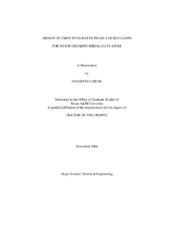| dc.description.abstract | High-speed serial data links are quickly gaining in popularity and replacing the
conventional parallel data links in recent years when the data rate of communication
exceeds one gigabits per second. Compared with parallel data links, serial data links are
able to achieve higher data rate and longer transfer distance. This dissertation is focused on
the design of CMOS integrated phase-locked loops (PLLs) and relevant building blocks
used in multi-gigabits serial data link transceivers.
Firstly, binary phase-locked loops (BPLLs, i.e., PLLs based on binary phase detectors) are
modeled and analyzed. The steady-state behavior of BPLLs is derived with combined
discrete-time and continuous-time analysis. The jitter performance characteristics of BPLLs
are analyzed. Secondly, a 10 Gbps clock and data recovery (CDR) chip for SONET OC-
192, the mainstream standard for optical serial data links, is presented. The CDR is based
on a novel referenceless dual-loop half-rate architecture. It includes a binary phase-locked
loop based on a quad-level phase detector and a linear frequency-locked loop based on a
linear frequency detector. The proposed architecture enables the CDR to achieve large locking range and small jitter generation at the same time. The prototype is implemented in
0.18 μm CMOS technology and consumes 250 mW under 1.8 V supply. The jitter
generation is 0.5 ps-rms and 4.8 ps-pp. The jitter peaking and jitter tolerance performance
exceeds the specifications defined by SONET OC-192 standard. Thirdly, a fully-differential
divide-by-eight injection-locked frequency divider with low power dissipation is presented.
The frequency divider consists of a four-stage ring of CML (current mode logic) latches. It
has a maximum operating frequency of 18 GHz. The ratio of locking range over center
frequency is up to 50%. The prototype chip is implemented in 0.18 μm CMOS technology
and consumes 3.6 mW under 1.8 V supply. Lastly, the design and optimization techniques
of fully differential charge pumps are discussed. Techniques are proposed to minimize the
nonidealities associated with a fully differential charge pump, including differential
mismatch, output current variation, low-speed glitches and high-speed glitches. The
performance improvement brought by the techniques is verified with simulations of
schematics designed in 0.35 μm CMOS technology. | en |


